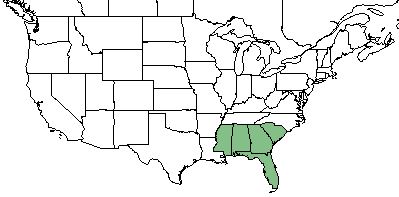Hypericum myrtifolium
Common name: myrtleleaf St. Johnswort; polebark St. Johnswort
| Hypericum myrtifolium | |
|---|---|

| |
| Photo by the Southeastern Flora Plant Database | |
| Scientific classification | |
| Kingdom: | Plantae |
| Division: | Magnoliophyta - Flowering plants |
| Class: | Magnoliopsida - Dicots |
| Order: | Theales |
| Family: | Clusiaceae |
| Genus: | Hypericum |
| Species: | H. myrtifolium |
| Binomial name | |
| Hypericum myrtifolium L | |

| |
| Natural range of Hypericum myrtifolium from USDA NRCS Plants Database. | |
Contents
Taxonomic Notes
Description
H. myrtifolium is a native perennial shrub that is a member of the Clusiaceae family. [1] It is most recognizable by its clasping leaves, which are usually glaucous. [2]
Distribution
H. myrtifolium is a southeastern coastal plain endemic species, found mainly in Florida, but can also be found sparingly in southern Alabama, Gerogia, and Mississippi.[1][3]
Ecology
Habitat
H. myrtifolium is primarily found in habitats surrounding ponds.[3] It is naturally found in fresh-water communities and marshes infrequently. [4] Other natural communities include sandhills and flatwoods. [5] More specifically, H. myrtifolium can be found in dry loamy sand in open pine woodlands, sand pine stands, moist loams of swales in pine woodland, and in shaded swamps.[6] It is listed by the USDA Natural Resources Conservation Service as a facultative wetland species that is most often found in wetland habitats but can also occasionally be found in non-wetland habitats.[1]
Associated species include Hypericum harperi.[6]
Phenology
H. myrtifolium commonly flowers from April until June.[7] It has been observed flowering from May to July as well as October to December. [8] [6].
Conservation and Management
Globally, Hypericum myrtifolium is listed as G4 due to it growing in endangered habitats, and not very common where it is found. It is also considered imperiled in Mississippi.[9]
Cultivation and restoration
Photo Gallery
References and notes
- ↑ 1.0 1.1 1.2 USDA Plants Database URL: https://plants.usda.gov/core/profile?symbol=HYMY
- ↑ Carr, L. G. (1940). "Further notes on coastal floral elements in the bogs of Augusta County, Virginia." Rhodora 42(495): 86-93.
- ↑ 3.0 3.1 Weakley, A. S. (2015). Flora of the Southern and Mid-Atlantic States. Chapel Hill, NC, University of North Carolina Herbarium.
- ↑ Hilmon, J. B. (1964). "Plants of the Caloosa Experimental Range " U.S. Forest Service Research Paper SE-12
- ↑ Platt, W. J., Gregory W. Evans, and Mary M. Davis (1988). "Effects of Fires Season on Flowering of Forbs and Shurbs in Longleaf Pine Forests." Oecologia 76(3): 353-363.
- ↑ 6.0 6.1 6.2 Florida State University Robert K. Godfrey Herbarium database. URL: http://herbarium.bio.fsu.edu. Last accessed: June 2018. Collectors: Loran C. Anderson, Wilson Baker, R. A. Norris, Robert K. Godfrey, R. Komarek, M. Davis, J. M. Kane, Cecil R. Slaughterm and R. Kral. States and counties: Florida: Leon, Wakulla, Duval, and Madison. Georgia: Thomas and Clinch.
- ↑ [[1]] Lady Bird Johnson Wildflower Center. Accessed: May 28, 2019
- ↑ Nelson, G. PanFlora: Plant data for the eastern United States with emphasis on the Southeastern Coastal Plains, Florida, and the Florida Panhandle. www.gilnelson.com/PanFlora/ Accessed: 22 MAY 2018
- ↑ [[2]] NatureServe Explorer. Accessed: May 28, 2019